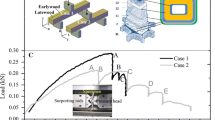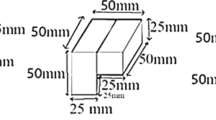Abstract
It is shown that bending stresses in a non-cracked hollow trunk can never explain failure. Consequently, stem breakage due to bending stress cannot be primary failure. It is shown by field studies and simple theoretical assessments that the initiation of a longitudinal shear crack is primarily responsible for failure. Due to cracking, the bending stresses increase and failure by bending happens as secondary failure. As a result, bending theory of a non-cracked closed circular pipe is inappropriate to describe failure of hollow trees. In the appendix is shown the reason for high shear stresses at the tree base and why the shear stresses increase more due to hollowness than to bending stresses.








Similar content being viewed by others
References
Mattheck C (2002) Tree mechanics, explained with sensitive words by pauli the bear, Verlag Forschungszentrum Karlsruhe GmbH
Mattheck C (2004) The face of failure in nature and engineering. Verlag, Forschungszentrum Karlsruhe GmbH
Mattheck C, Bethge K, Erb D (1993a) Failure criteria for trees. Arboricult J 201–209
Mattheck C, Bethge K, Schäfer J (1993b) Safety factors in trees. J Theor Biol 165:185–189
Mattheck C, Breloer H (1994) The body language of trees, a handbook for failure analysis. HMSO, London
Mattheck C, Bethge K, West PW, (1994) Breakage of hollow tree stems, Trees, Struct Funct 9:47–50
Shigo AL (1977) Compartmentalization of decay in trees. USDA Forest Service, Agric Info Bull 387.
Smiley T, Fraedrich B (1992) Determining strength loss from decay. Arboricult J 18:201–204
Tesari I, Mattheck C (2003) Das Schubspannungsmaximum am Stammfuss und der Einfluss von Wurzelarchitektur und Bodeneigenschaften. In: Proceedings of the 9th VTA-Spezialseminar “Messen und Beurteilen am Baum”, Forschungszentrum Karlsruhe GmbH, 1–2 April 2003
Wagener WW (1963) Judging hazard from native trees in California recreation areas, US forest service research paper PSW-P1
Wessolly L, Erb M (1998) Handbuch der Baumstatik und Baumkontrolle, Patzer Verlag
Young WC (1989) Roark's formulas for stress and strain, 6th edn., McGraw-Hill, New York
Acknowledgment
The authors like to thank the two referees for fruitful recommendations.
Author information
Authors and Affiliations
Corresponding author
Appendices
Appendix A
The equations for shear stresses and bending stresses in hollow and non-hollow circular trunks are already given in existing publications, for example Young (1989) or Mattheck (2002).
Figure 6 shows the increase of bending and shear stresses in hollow trunks, standardized to the values in solid trunks, respectively.
The shear stresses increase much more with the increasing hollowness (decreasing t/R ratio) than the bending stresses. This can be easily understood by the fact that the shear stresses are maximum in the centre of the trunk whilst bending stresses have their neutral fibre of bending (zero stress) there. If one takes out the middle of the trunk by decay the impact on bending and shear stresses has therefore to be different (Mattheck 2002).
However, there is also a shear bomb in the butt of even non-hollow trees (Mattheck 2004), which is briefly described Appendix B.
Appendix B
Crossing tensile and compressive stresses at the tree butt may lead up to approximately 50 times higher shear stresses compared to a situation somewhat higher up in the tree. This can initiate shear cracks even in solid non-decayed trunks in nature. Especially oaks suffer from this fact, as their large rays are potential slip lines along the shear plane.
Figure 7 shows why tensile and compressive stresses cross at the base of a tree. A stress state of pure torsion is created, where tensile, compressive and shear stresses are of same magnitude. A 2D-finite-element-simulation shows a 46-fold stress magnification in flat-rooting trees.
In order to show the magnification of shear stresses quantitatively, FEM-calculations have been performed (Tesari and Mattheck 2003). As an example Fig. 8 shows a flat-rooting tree whose sinker roots are anchoring further away from the trunk.
Appendices A and B reveal, that the hollowness has more impact on shear than on bending stresses and that especially trees anchoring further away from the trunk (i.e. also for trees with decay in the sinker roots below the stem!) have a shear stress concentration due to crossing force flow in the base of the trunk. In hollow trees this shear bomb is existing in the same way but shifted in the shell of the hollow tree base, promoting shear crack formation (Tesari and Mattheck 2003).
Rights and permissions
About this article
Cite this article
Mattheck, C., Bethge, K. & Tesari, I. Shear effects on failure of hollow trees. Trees 20, 329–333 (2006). https://doi.org/10.1007/s00468-005-0044-0
Received:
Accepted:
Published:
Issue Date:
DOI: https://doi.org/10.1007/s00468-005-0044-0




